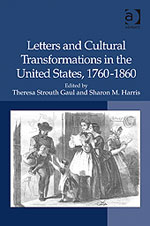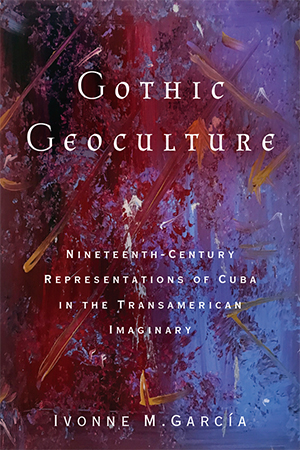“Gothic Geoculture: Nineteenth-Century Representations of Cuba in the Transamerican Imaginary”
In the nineteenth century, the island of Cuba was a popular site for U.S. travelers, who wrote dozens of travelogues about their experiences. At the same time, Cuban exiles living in the United States, escaping from Spanish colonial repression, wrote about their island and about their U.S. experiences. Within the trove of writings about Cuba in relation to slavery and a rising U.S. empire in the region, Ivonne M. García’s Gothic Geoculture: Nineteenth-Century Representations of Cuba in the Transamerican Imaginary shows how a group of writers, on both sides, used the language of fear to construct gothicizations of the island (and of the United States) through tropes of corruption, doubleness, and monstrosity. García coins the term “gothic geoculture” to show Cuba’s identity in the nineteenth century as existing at the crossroads between colonialism, slavery, and transamericanity. Specifically looking at a period of colonial anxiety between 1830 and 1890, García exposes the ways some writers code Cuba as dangerous and destructive, demonstrating how these transamerican figurations created a series of uncanny simultaneities that expand on and complicate the ways we understand how Cuba and the hemisphere were imagined at that time.
See more or buy the book at The Ohio State University Press web site.
Other publications
2019
- “Transcolonial Gothic and Decolonial Satire in Ramón Emeterio Betances’ ‘The Virgin of Borinquen’ and ‘The Travels of Escaldado,'” The Oxford Handbook of Latino Studies, Ed. Ilan Stavans.
- “ ‘A world defined by immigration’: Ambivalence, Translationality, and Mestizaje in Ilan Stavans,” Ilan Stavans Unbound: The Critic Between Two Canons, Academic Studies Press.
2018
- “Diasporic Intersectionality: Colonial History and Puerto Rican Hero Narratives in Wilfred Santiago’s ‘21’: The Story of Roberto Clemente-A Graphic Novel and Edgardo Miranda-Rodríguez’s La Borinqueña.” The Routledge Companion to Gender, Sex and Pop Culture in Latin America, Frederick Aldama, Ed. Routledge.
2017
- “A Post-Nationalist Approach to Teaching Hawthorne,” Teaching the Works of Nathaniel Hawthorne, Eds. Sam Cole and Christopher Diller, AMS Press.
2016
- “Historia ficción o ficción histórica en La séptima vida de Juan M. García Passalacqua” (Historical Fiction or Fictionalized History in The Seventh Life), University of Turabo, PR
- “Gothic Cuba and the Trans-American South in Louisa May Alcott’s ‘M.L.,’” The Handbook of Southern Gothic, Palgrave-McMillan.
- “‘Local locas’: Trans-Antillean Queerness in Mayra Santos-Febres’s Sirena Selena,” The Edinburgh Companion to Atlantic Literary Studies, Edinburgh University Press.
2009-2014
- “‘With the Eyes that are Given Me’: Transcendentalist Individualism and Feminist Colonial Poetics in Sophia Peabody’s Cuba Journal.” Toward A Female Genealogy of Transcendentalism. Eds. Jana L. Argersinger and Phyllis Cole. Athens, GA: University of Georgia Press.
- “Transnational Crossings: Sophia Hawthorne’s Authorial Persona from The Cuba Journal to Notes in England and Italy.” Nathaniel Hawthorne Review 37.2 — Fall 2011, Ed. Julie Hall and Monika M. Elbert. This article was recognized with the Nathaniel Hawthorne Society’s 2011 Award for Best Essay by Junior Faculty.
 “Anticipating Colonialism: American Letters from Puerto Rico and Cuba, 1831-1835,” a chapter in Letters and Cultural Transformations in the United States, 1760-1860. Eds. Theresa Strouth Gaul and Sharon M. Harris. Ashgate.
“Anticipating Colonialism: American Letters from Puerto Rico and Cuba, 1831-1835,” a chapter in Letters and Cultural Transformations in the United States, 1760-1860. Eds. Theresa Strouth Gaul and Sharon M. Harris. Ashgate.
The following documents are available on this site. All documents are in .pdf format and all material is copyrighted.
- “Laboring to Globalize a First-Year Writing Program” (with Wendy Hesford and Eddie Singleton). Interrupting the Program: Critical Questions in Writing Program Administration. Eds. Jeanne Gunner and Donna Strickland. Boynton/Cook, 2009 (11.5MB)
- “Puerto Ricans Find ‘Dream’ Elusive,” published in The Columbus Dispatch, August 2009 (1.5MB)
- Review of Ambassadors of Culture: The Transamerican Origins of Latino Writing by Kirsten Silva Gruesz. American Periodicals 15.1 (2005): 114-116 (197KB)

